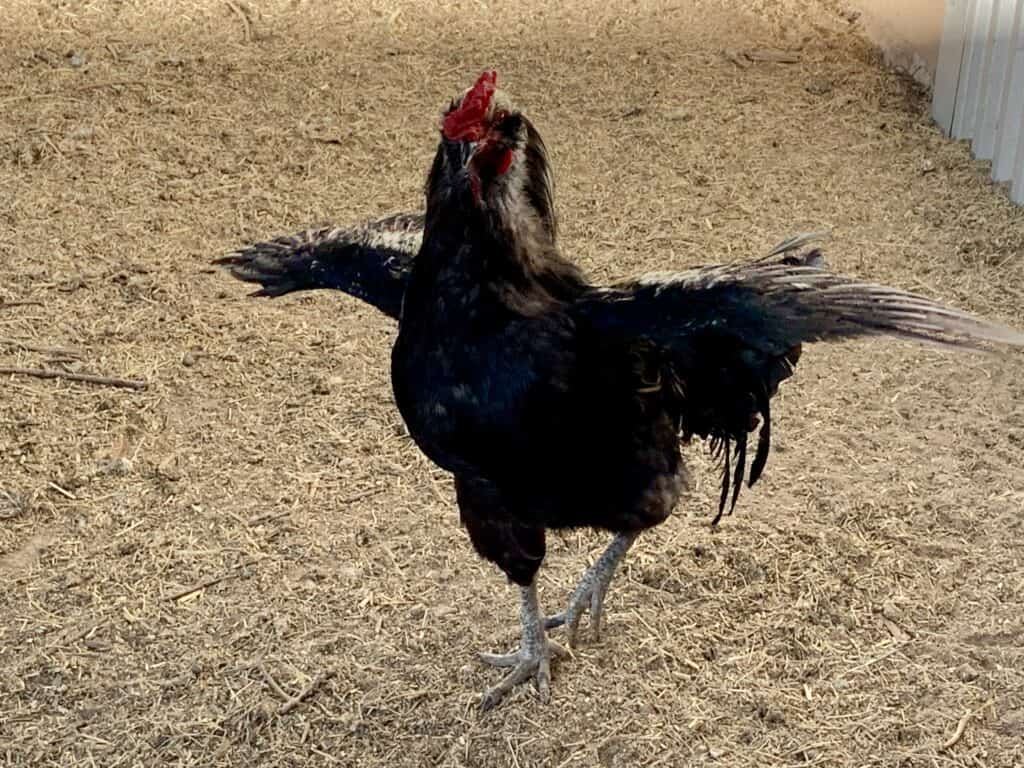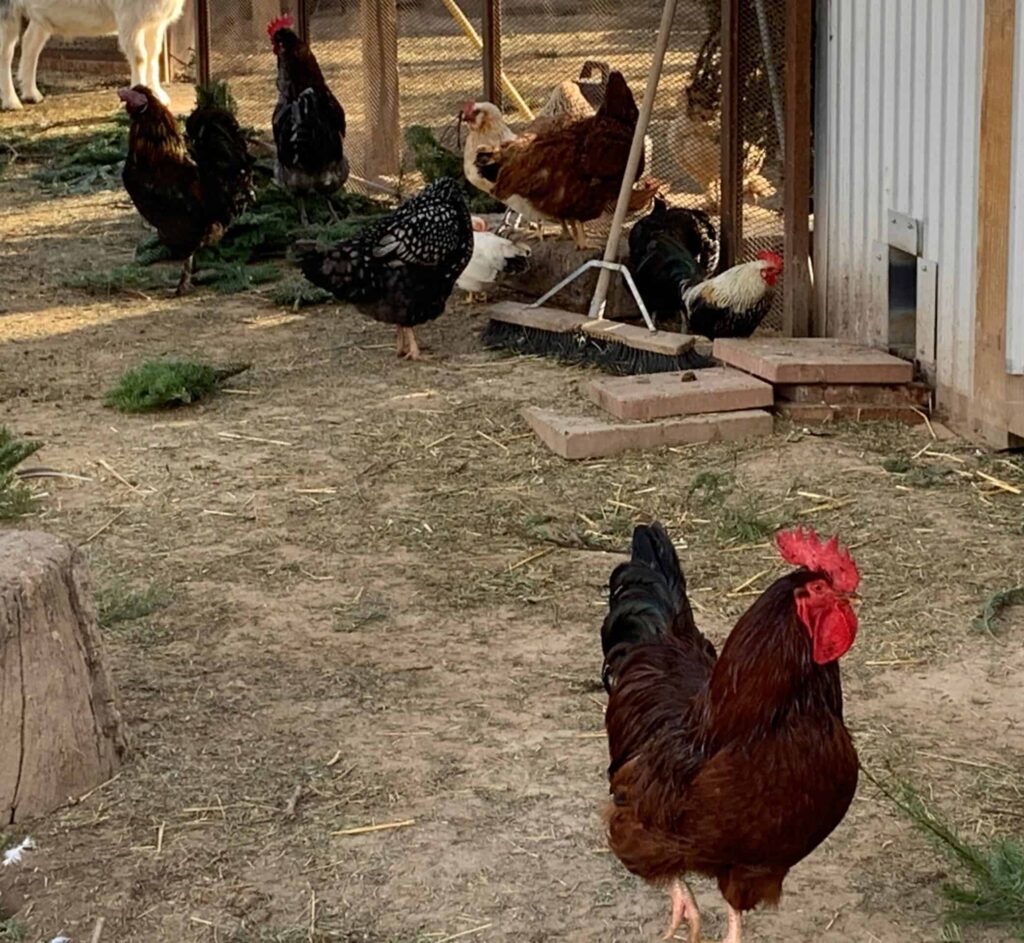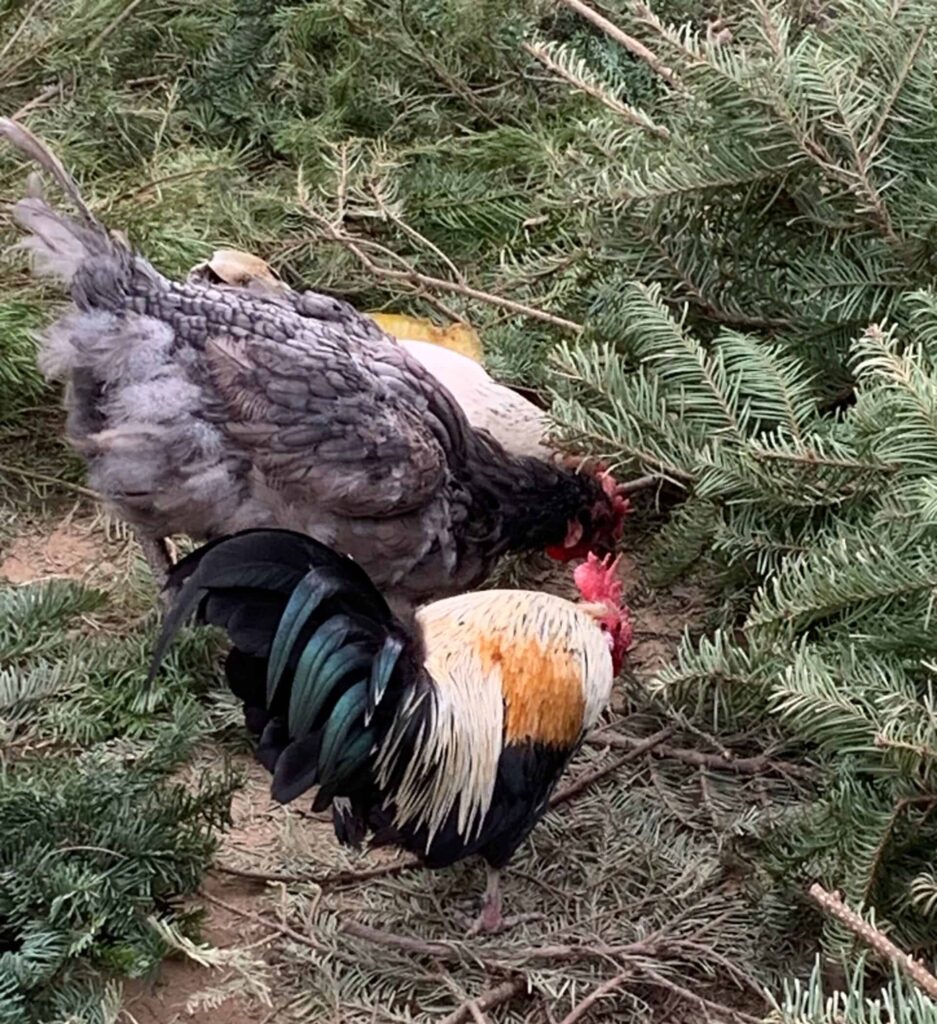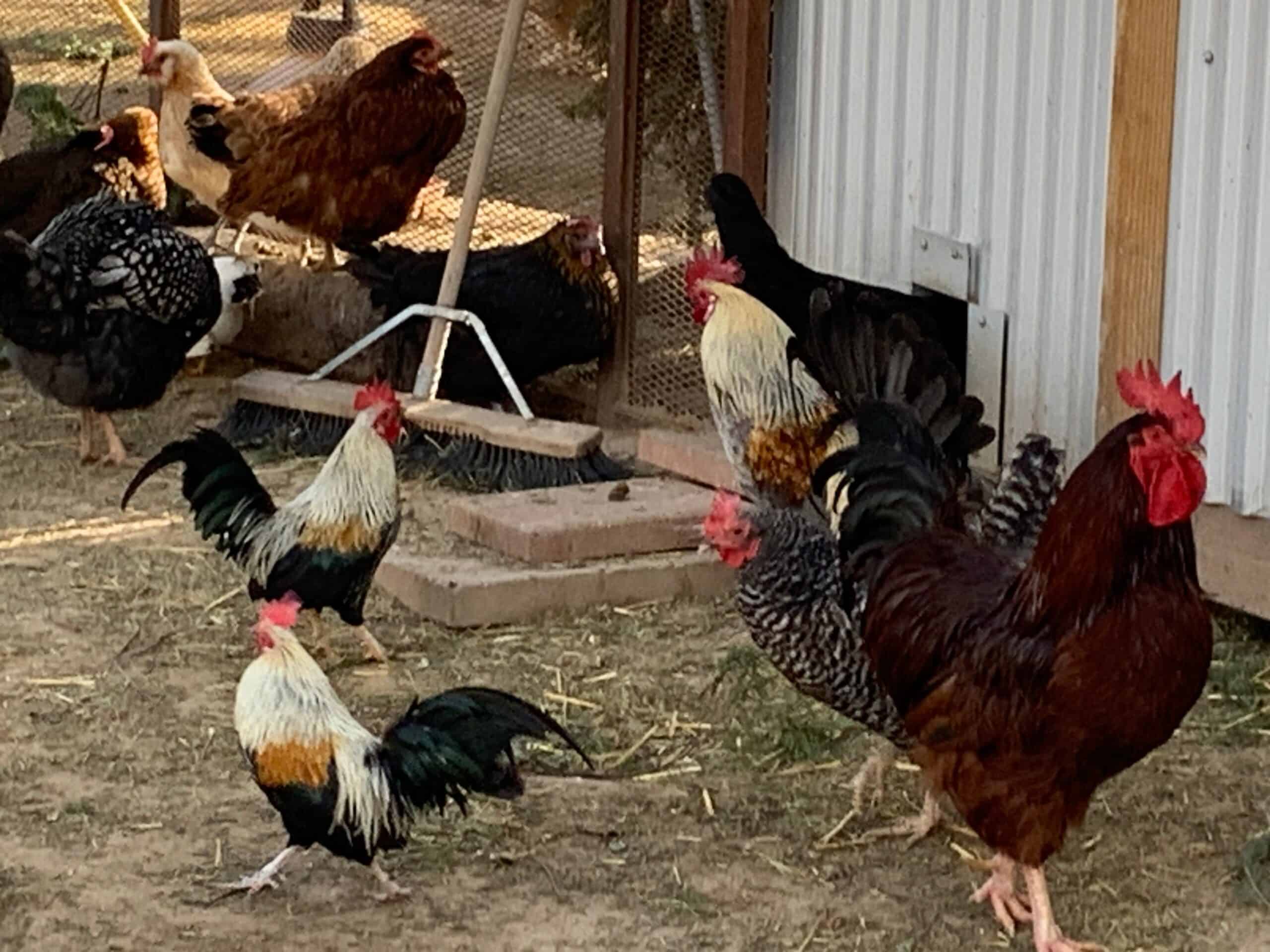Last Updated on October 10, 2024 by Alice Benny
It’s common to wonder: Can you eat roosters? Yes, roosters are edible. Roosters are male chickens. Their meat is a bit tougher and stringer than meat from hens but when slow-cooked on low in stews, etc.. I think it’s tasty.
Most people who raise chickens tend to prefer raising hens because of their eggs and meat. When flock owners hatch chicks, they usually hope for females. When there are male chicks, it’s decision time:
- Raise them among their flock
- Raise the males to eat them
- Give them away or sell them
Many chicken keepers do not want to raise a rooster. Or they may already have a rooster and don’t want another. Some quick reasons someone may not want a rooster or more than one rooster:
- In many backyards, it’s difficult to keep more than one rooster because of space.
- Roosters are typically aggressive and fight for dominance with other males.
- It’s important to keep enough hens per rooster (8 – 10 hens is ideal) to ensure the hen’s health and safety.
- Roosters crow and can disturb neighbors.
- Some areas have ordinances about keeping roosters.
It may be suitable to keep all the males and raise roosters in some situations, especially with friendly breeds and if someone has a lot of hens. Otherwise, often people give the roosters away or raise them until they are large enough to slaughter for meat.
I’m going to explain what there is to know about using roosters for meat so you can understand this often overlooked source of poultry. Here’s everything to know about eating roosters / male chickens.
Can You Eat Roosters? Yes! Cockerels Too
Yes, you can eat roosters. Roosters and cockerels (both terms for male chickens depending on their ages), have been used for meat for centuries.
Eating the roosters when they are younger — still a cockerel — results in more tender meat similar to a hen’s. Many flock owners prefer using them young because it’s less time you have to feed them.
Homesteaders will often raise cockerels until they are between 4 – 6 months old, depending on the breed, and then cull them for meat.
Roosters that are several years old can also be eaten. The meat will be tougher though. I think cooking rooster meat slowly in soups and stews is better than frying, roasting, or grilling it on its own. Keeping moisture will help prevent this already-drier meat from drying out further.

Rooster Meat vs Hen Meat
Rooster meat is similar to hen meat in terms of taste. While both offer protein, the distribution of fat within the bird’s body differs between roosters and hens. This difference in fat content affects how you cook the meat and the final texture you achieve.
Rooster Meat
The fat in roosters is predominantly situated just beneath their skin. This feature allows for the easy removal of fat during butchering, yielding a lean piece of meat. However, this characteristic of roosters also presents a challenge:
- Lack of internal fat: Roosters have less intramuscular fat, which can result in tougher meat if not prepared correctly.
- Rooster meat often tastes gamey with a stronger flavor
- Tougher texture due to their muscular build
- Meat from roosters is drier
- Becomes stringier the older the rooster
Meat from Hens
Unlike roosters, hens possess more intramuscular fat. This particularly holds true for the darker portions of their meat. This key distinction has its own implications:
- Increased tenderness: The higher level of intramuscular fat makes hen meat more tender, allowing for a more forgiving cooking process.
- Chicken is what is sold in grocery stores
- Chicken meat is tender, mild, moist, flavorful
- Can be prepared and used in many ways
- It’s more “forgiving” to prepare
- Commercial chickens are from meat-producing hens, such as Cornish Cross chickens, not chickens bred for egg production
The fat distribution patterns in roosters and hens result in different culinary outcomes, each requiring specific cooking techniques to ensure the best flavor and texture.
Roosters generally have a stronger flavor and firmer texture compared to hens. It’s often more stringy than what you buy from the store (which is “chicken” from hens). While everyone’s tastes differ, cooking and using rooster meat differently than you would meat from hens makes it consumable.

Male Chickens and Roosters
In the world of poultry, various terms are used to define male chickens at different stages of their life. Here’s a brief rundown:
Chick: This term is used for both male and female chickens from birth until they begin to feather, generally around 6 weeks old.
Cockerel: A cockerel is a young male chicken that’s less than one year old. At this age, they are starting to exhibit signs of their sex, such as growing larger combs and wattles, and beginning to crow.
Rooster: A rooster is a male chicken that is one year old or older. They are fully mature and possess all the distinguishing features of their breed and sex, including a full comb and wattle, spurs, aggression, dominance, and the ability to crow loudly. Learn more: why do roosters crow
Cock: Another name for a rooster.
Capon: Capons are male chickens that have been castrated at a young age, typically when they are 6 to 20 weeks old. This process, although less common today, was traditionally done to make the birds more docile and to encourage weight gain for a more tender and flavorful meat. You can sometimes find capon in the frozen section at the grocery store.
When Should You Eat a Rooster
The best age to eat a rooster is when it’s still a cockerel. Depending on the breed, the best time to use it for meat is when it’s 4 – 6 months old. In general, chicken breeds typically reach maturity around 5 months, and by this time, you’ll have enough meat to make it worth your while.
The advantage of culling cockerels is there is less cost to feed them, and many people think their meat tastes better. The meat from a cockerel more closely mirrors the taste of hen.
As roosters age, their meat usually becomes tougher, more robust with a stronger flavor, and somewhat stringy. It also has a more pronounced, gamey flavor. Therefore, to maximize meat taste-wise from male chickens, eat them when they are a few months old.
However, you can still eat roosters when they are older. It’s best to slow roast it or simmer it for hours in a slow cooker. You can also cook rooster in a covered Dutch oven on low heat. Just be sure to add liquid so it doesn’t dry out. Cooking slow and low ensures that you extract the best flavor and texture from the rooster meat.

When to Use Roosters for Meat
Male chickens can be culled and slaughtered at various ages, depending on the desired meat quality:
Broilers and Fryers
Young meat-type chicken. These are typically culled young, often between 6 to 12 weeks of age, of either sex. At this age, their meat is tender and milder in flavor. They can be cooked tender by broiling or frying.
At 3 to 5 pounds, they will dress a 2 ½ to 4-pound carcass. When some breeds weigh 2 ½ to 3 ½ pounds, they can be culled.
A good broiler breed for meat is the Jumbo Cornish X Rock or the Cornish Cross chicken which were bred gain weight quickly. Cornish Crosses can be ready to process in 6 – 8 weeks and will weigh around 5 pounds.
Roasters
These are older birds, called cockerels. They are usually culled between 5 to 7 months of age. They are larger and have more fat, making them ideal for roasting, which requires longer, slower cooking.
Roosters
Mature male birds, roosters and cocks, are typically culled anywhere from 1 to 3 years of age. Their meat is firmer and more flavorful, making it ideal for slow-cooking methods such as stewing or braising.
No matter their age…
Slaughtering and butchering birds for meat should be done humanely, adhering to proper standards and guidelines. With careful planning and management, raising male chickens for meat can be an efficient and productive aspect of homesteading.
Why Homesteaders Opt for to Rehome or Cull Roosters
Raising several roosters within a flock often poses challenges for homesteaders and poultry owners, leading to the decision to either give the roosters away or utilize them as a source of meat.
While there are many pros and cons to raising roosters, one of the biggest issues is the inherent nature of roosters. Roosters are naturally territorial and competitive, particularly when it comes to mating. Having multiple roosters can result in frequent fights for dominance, leading to injuries and stress within the flock.
With multiple roosters, hens may be subjected to over-mating, causing them physical harm and significant stress. Excessive mating can lead to feather loss, injuries, and reduced egg-laying.
In addition, resources such as feed and space also factor into the equation. More roosters mean more mouths to feed without an increase in egg production, thus affecting the efficiency of the flock. Similarly, coop space is limited, and an excess of roosters can lead to overcrowding, causing stress and potentially facilitating the spread of disease.
Finally, the noise factor can be a nuisance. Roosters are renowned for their early morning crowing, which in limited numbers can be tolerable or even charming. However, multiple roosters crowing can lead to significant noise levels, potentially disturbing the household and neighbors, especially in urban or suburban settings.
Considering these challenges, giving roosters away to other flock owners or farms can be an option, although finding willing and responsible takers can be tough. This means many decide to cull the roosters for meat for utility from them.
Why Are Roosters Eaten?
The question, “do we eat roosters?” is best answered by understanding the cultural and culinary contexts in which roosters are consumed. In many parts of the world, rooster meat is valued for its unique taste and texture.
It is used in traditional dishes, particularly ones that require long cooking times, like coq au vin in France or cock-a-leekie soup in Scotland. Rooster meat is robust and holds up well to slow-cooking methods, making it an excellent choice for stews and soups.
Roosters are also eaten as a way to “do something” with the males. Roosters can be difficult to raise. Using them as a meat source gives them a purpose.
Costs with Raising Roosters
Raising male chickens to maturity costs money in feed. If you plan to use them for meat, it’s best to keep them only as long as it takes for them to reach the desired weight for slaughter.
According to the University of Minnesota Extension, it takes around 5 pounds of feed to raise a chicken to 6 weeks old. It takes 8 – 9 pounds of feed to raise them to be 8 weeks old for commercial strains. This applies to the males as well. In addition, capons and roasters require more feed per pound of meat they produce than fryers do.
There are also costs with regards to needing more space, chicken bedding, etc.
List of the Best Edible Rooster Breeds
While you can eat most all roosters, breed matters regarding meat quality. Certain breeds are known for their high-quality meat, making them ideal choices for those interested in eating roosters. These breeds are known for their large size, ability to gain weight quickly, and excellent meat quality.
- Jumbo Cornish X Rock
- Cornish Cross
- Jersey Giant
- Plymouth Rock
- Speckled Sussex
Learn more about the best meat chickens.
Some types of roosters aren’t typically favored for their meat. For example, the Leghorn and Ancona chicken breeds are primarily raised for egg production, and their leaner bodies result in less meat yield and a tougher texture. The roosters are edible but the meat won’t be as plentiful and may be more stringy and tougher.
Benefits of Eating Roosters
Culling roosters for meat can offer several benefits, from maintaining a healthy flock to providing a nutritious food source. It helps contribute to a more efficient and sustainable homesteading operation. Here are a few advantages:
Flock health and harmony: Too many roosters can stress hens and cause disruptions within the flock. By culling the excess roosters, you can maintain a balanced and more peaceful flock environment.
Prevent overbreeding: Too many roosters can lead to over-mating, which can be physically stressful and even harmful for the hens. Culling roosters can help to maintain a healthier and more balanced mating dynamic. Learn more: How do chickens mate
Resource management: Roosters consume the same resources (food, space requirements, care, chicken bedding and cleaning, etc.) as hens but without laying eggs.
Using cockerels and roosters for meat helps ensure the resources aren’t being expended without a return, making homesteading efforts more efficient and sustainable.
Nutritious food source: Like meat from chickens, rooster meat is high in protein and provides essential vitamins and minerals. It can be better than chicken from the store, particularly in free-range or organic farming scenarios.
Ethical choice: It’s often difficult to get rid of roosters or younger male cockerels. The act of culling can be considered an ethical choice, particularly with older roosters.
Use for older roosters: When roosters age, their ability to breed and protect the flock diminishes. By culling old roosters, you can ensure they have a swift, humane end rather than succumbing slowly to the hardships of aging.
And culling aging roosters also makes space for younger, more productive roosters in your flock.
Respectful and Humane
To maximize these benefits, it’s important to adhere to respectful and humane practices throughout the process, from raising the cockerels and roosters to the act of culling.
In doing so, the cycle of life on the homestead is honored: the rooster’s contribution to the farm is acknowledged and valued.
Reasons to Eat Roosters vs Raise Roosters
Raising roosters comes with its own set of challenges and considerations. Here are several reasons why a flock owner might choose to eat roosters vs raising them until old age:
Noise: Roosters are known for their loud crowing, which can be disruptive, especially in urban or suburban settings. This could lead to complaints from neighbors.
Aggressive behavior: Roosters can sometimes be aggressive, particularly toward other roosters. This can lead to fights, injuries, and general stress in the flock.
Legal restrictions: Many urban areas have regulations against keeping roosters due to noise and space concerns. Violating these rules could lead to fines or other penalties.
Overpopulation: If a flock already has a rooster, introducing more could lead to overpopulation issues, especially if there are also hens present. While chickens don’t need a rooster to lay eggs, with a rooster, hens will lay fertile eggs. If you hatch chicks, it’s likely you will end up with some males.
Feeding and care: Like all animals, roosters require regular care, including feeding, cleaning, and health checks. This can be time-consuming and costly, particularly if the primary interest is in egg production rather than meat.
Limited egg production: Unlike hens, roosters don’t lay eggs. For those interested primarily in egg production, investing time, space, and resources into raising roosters might not make sense.
Tougher meat: Rooster meat is typically tougher and stronger in flavor than hen meat. It requires specific, usually longer, cooking methods to ensure tenderness, which might not align with everyone’s tastes or skills.
Difficulty in finding homes: If you’re hatching your own chicks and end up with more roosters than you can handle, finding them suitable homes can be challenging. Many people prefer hens, so roosters can often be harder to rehome.
Age-related decline: Roosters maintain their productivity primarily up until their third year. Post this period, they may struggle to breed and protect their flock due to aging. Their ability to ward off diseases, illnesses, injuries, and adapt to environmental changes diminishes over time.
Typically a rooster lifespan is 5 – 8 years, after which their health gradually declines. Given these circumstances, a humane approach may involve using these aging roosters for consumption to make space for younger, more productive roosters in the flock.
Negative traits: A rooster contributes significantly to the traits of your future flock. Undesirable characteristics, in terms of health, physical attributes, or temperament, are valid reasons to consider the rooster for consumption rather than breeding. Culling these roosters becomes practical to ensure the best genetic traits in your flock.
FAQs
Why do homesteaders eat roosters?
It’s difficult to keep several roosters at a time due to their inherent aggressive traits. You also have to be sure to have enough hens so “the favorite” isn’t sought out too frequently which can cause health issues.
Eating roosters is a way to “not waste” the males. Traditional homesteading practices involve using every part of an animal to minimize waste, and this applies to roosters as well.
How can you prepare rooster meat?
Whether it’s in a slow-cooked stew, a spicy curry, or a flavorful soup, preparing rooster in a moisture-rich recipe is key. Rooster meat is drier and often gets stringy. Cooking it at low temperatures helps to retain moisture.
What does rooster meat taste like?
Rooster meat tastes more gamey than chicken. It usually has a tougher texture and is drier which makes preparation key. Chicken is more forgiving to prepare whereas rooster is best cooked slowly in moisture-rich recipes like stews.
Why don’t we eat roosters?
While people can eat roosters, when we buy chicken meat from the store, it’s from chickens who were bred to provide meat quickly. These are hens who were bred for their meat instead of eggs.
Meat from hens is flavorful, moist, and more versatile than rooster meat. It makes more sense economically for chicken farms to raise females instead of the males for meat.
In addition, hens’ dispositions are more mild-mannered than males, making them easier to raise. Typically when people eat roosters it’s because they raise chickens in their flock, and they don’t want to raise the males alongside their hens.
Can I raise roosters for meat?
Yes, you can raise roosters for meat. What you would want to do is raise a broiler chicken breed alongside a the same breed of rooster to hatch fertile chicks. When you hatch chicks, you could raise the both the males and females for meat. Broiler chickens reach market weight quickly and are bred to provide meat.
For example, if you raise Cornish Cross hens and a rooster, the males will be more meaty than those from chickens who were bred to lay a lot of eggs.
What is capon?
A capon is a male chicken that has been castrated before reaching sexual maturity. It’s younger than a rooster. The process, known as caponization, results in a bird that grows larger and develops more body fat than typical roosters.
They are often prized for their tender and flavorful meat, which is a result of their slower growth and increased fat content.
Eating Roosters: A Homesteading Perspective
Many people raise chickens for their utility. Hens are often prized for their egg-laying capabilities, while roosters play a vital role in poultry reproduction and as protectors of their flocks. An abundance of roosters, either from purchasing chicks or hatching eggs, leads to a common question: “Can you eat roosters?” The answer is a definitive yes.
When you raise roosters in a responsible and humane way, they do more than just maintain the flock. They also become a source of food for your homestead.
The Role and Value of Roosters
Various factors influence the decision to raise roosters among your flock, use them for meat, or give them away/sell them. These include:
- Age
- Temperament, behavior, aggression, noise
- Flock size
- Cost for feeding and housing
- Having enough hens
Many chicken breeds are bred for either egg or meat production, with many being dual-purpose. Notably, breeds known for meat yield more meat and/or more flavorful meat. Beyond their role in protecting and maintaining the chicken population, roosters have found their way onto the dinner table in many cultures, adding variety and sustainability to our diet.
Rooster Meat: A Sustainable and Nutritious Choice
Rooster meat is often misunderstood, leading to queries like “can you eat roosters”, “are roosters edible?” and “do we eat hens or roosters?” While roosters may not be the first choice for those seeking chicken meat, they can certainly hold their own in the culinary world.
Roosters’ robust flavor profile makes them ideal for slow-cooking methods, and their leaner meat can be a healthier option for many. Whether it’s a French coq au vin or a hearty rooster stew, rooster meat can be a flavorful, sustainable alternative to other types of poultry.
In summary, the answer to “Can you eat roosters?” is a resounding yes. Their unique taste, the cultural dishes rooster meat goes well in, and the breeds known for their superior meat all are reasons to cull male chickens you don’t want to raise. Using them for meat is “something to do with them.”
Roosters, when raised responsibly and humanely, provide a source of nourishment. Using roosters for meat is a way homesteading promotes self-sufficiency and respect for the life cycle.
Learn more:
- Tips for raising roosters and if they are right for your homestead
- 9 things to consider before raising chickens
- What I wish I knew before getting chickens

